US stock futures inch lower after Wall St marks fresh records on tech gains
Introduction & Market Context
Clariant AG (SIX:CLN) presented its second quarter and first half 2025 results on July 31, revealing a mixed performance characterized by improved profitability despite challenging market conditions. The specialty chemicals company has adjusted its full-year growth expectations downward while maintaining its profitability targets, as it continues to execute its restructuring program and shift toward consumer-facing markets.
The presentation comes after a relatively strong first quarter, where the company had reported a modest 1% sales growth in local currencies. However, the second quarter results indicate deteriorating market conditions, particularly in industrial production, which has prompted the company to revise its annual guidance.
Quarterly Performance Highlights
Clariant reported Q2 2025 sales of CHF 968 million, down 8% from CHF 1,056 million in the same period last year. The decline was primarily driven by negative currency effects (-8%) and lower volumes (-3%), partially offset by price increases (+3%).
Despite the sales decline, the company improved its profitability with EBITDA before exceptional items reaching CHF 169 million, representing a margin of 17.5% compared to 15.5% in Q2 2024. This improvement reflects the company’s ongoing restructuring efforts and focus on higher-margin segments.
As shown in the following chart of Q2 and H1 2025 highlights:
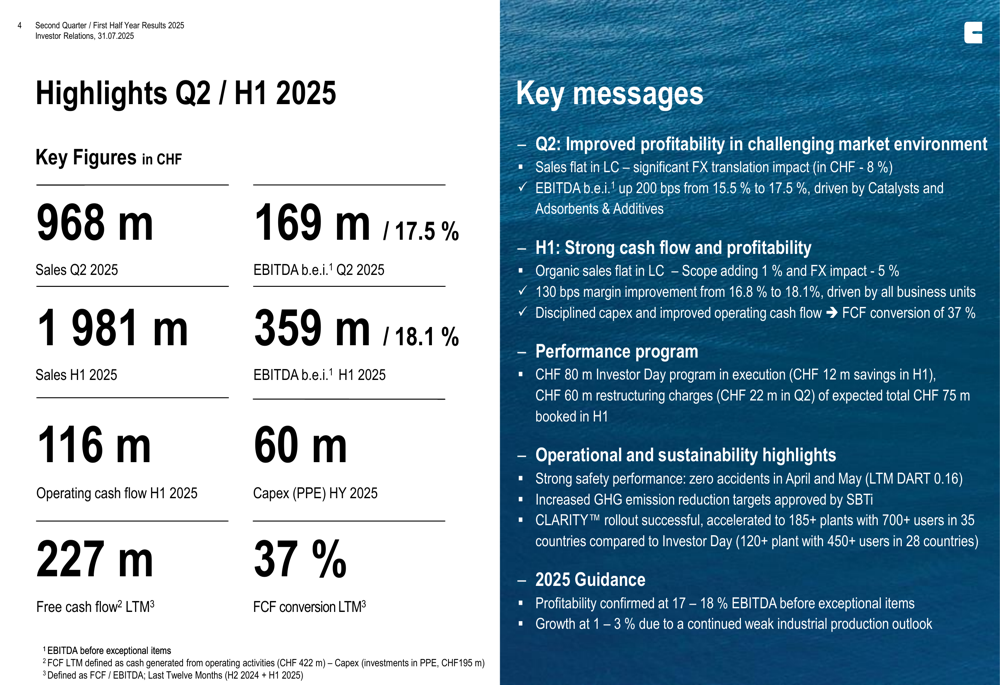
For the first half of 2025, Clariant recorded sales of CHF 1,981 million and EBITDA before exceptional items of CHF 359 million, resulting in an 18.1% margin. The company generated an operating cash flow of CHF 116 million and reported free cash flow of CHF 227 million on a last twelve months basis, with a free cash flow conversion rate of 37%.
Segment Performance
Clariant’s three business segments showed varying performance in the second quarter:
The Care Chemicals segment, which represents the largest portion of Clariant’s business, reported sales of CHF 497 million, down from CHF 565 million in Q2 2024. EBITDA before exceptional items reached CHF 88 million with a margin of 17.7%, down from CHF 100 million and 17.7% in the prior year. The segment faced volume declines, although pricing remained stable.
In contrast, the Catalysts segment showed strong sequential improvement with sales of CHF 218 million and EBITDA before exceptional items of CHF 49 million, resulting in a margin of 22.5% compared to 18.5% in Q2 2024. This improvement was driven by volume increases and stable pricing.
The Adsorbents & Additives segment reported sales of CHF 253 million and EBITDA before exceptional items of CHF 50 million, achieving a margin of 19.8% versus 16.0% in the same period last year. The segment benefited from slightly higher pricing while volumes remained flat.
The following chart illustrates the Q2 EBITDA analysis:
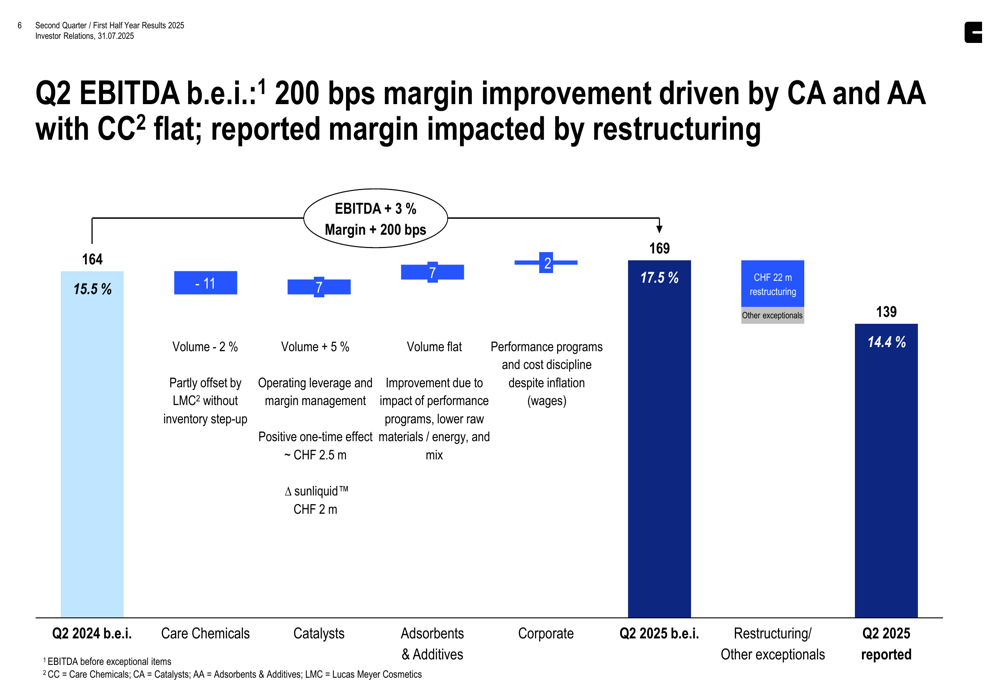
Strategic Initiatives & Restructuring
A key focus of Clariant’s presentation was its ongoing restructuring program announced at the Investor Day 2024, which aims to deliver CHF 80 million in savings by 2027. The company reported that it has already achieved CHF 12 million in run-rate savings (CHF 3 million in Q1 and CHF 9 million in Q2).
The savings program includes headcount reduction, footprint optimization, and procurement savings. Clariant has incurred CHF 60 million in restructuring charges related to this program and expects total restructuring charges of CHF 75 million for 2025.
The company’s strategic shift toward consumer markets continues, with consumer exposure now exceeding 50% of sales and still increasing. This shift is part of Clariant’s strategy to reduce cyclicality and improve margin stability.
As shown in the following chart of the savings program progress:
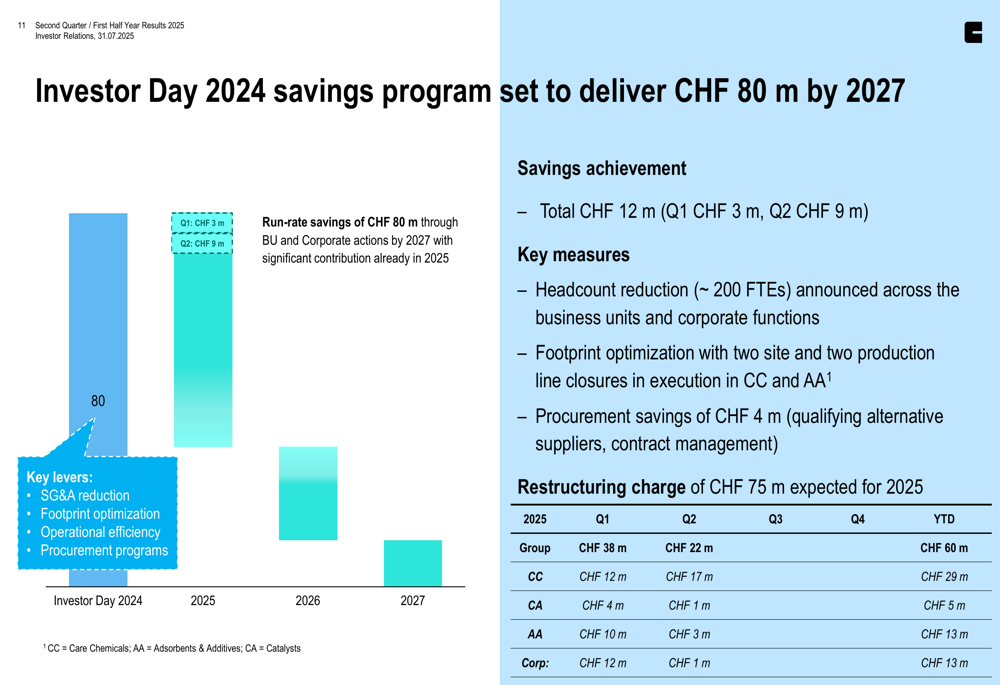
Outlook & Guidance
Clariant has adjusted its 2025 outlook, now expecting sales growth of 1-3% in local currency, down from the previous guidance of the lower end of a 3-5% range. This adjustment reflects the continued weak industrial production outlook globally.
Despite the lower growth expectations, the company has maintained its profitability guidance, targeting an EBITDA margin before exceptional items of 17-18% for 2025, compared to 16.0% in 2024.
For the medium term, Clariant reiterated its targets of 4-6% compound annual growth rate in sales, an EBITDA margin between 19-21%, and a free cash flow conversion of around 40%.
The following slide outlines Clariant’s outlook and medium-term targets:
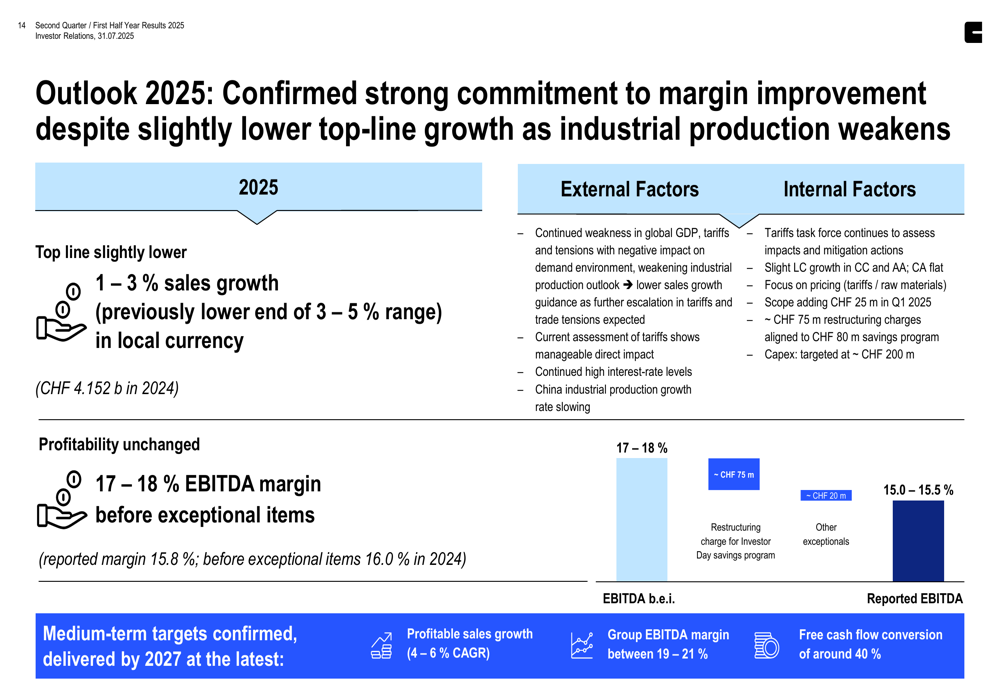
Investors should note that Clariant’s return on invested capital (ROIC) has declined to 6.6% in the first half of 2025, below its cost of capital of 8% and down from 9.2% in fiscal year 2024. This decline suggests challenges in value creation despite the improved margins.
Sustainability Progress
Clariant continues to make progress on its sustainability goals, reporting a 46.9% reduction in Scope 1 and 2 emissions and a 27.5% reduction in Scope 3.1 emissions since 2019. The company highlighted its commitment to fighting climate change, increasing circularity, achieving zero waste and pollution, developing a sustainable bioeconomy, and creating social value.
The company’s sustainability efforts are reflected in its improved ratings from major ESG rating agencies, positioning Clariant as a leader in sustainability within the chemical industry.
The following chart illustrates Clariant’s ESG and sustainability transformation:
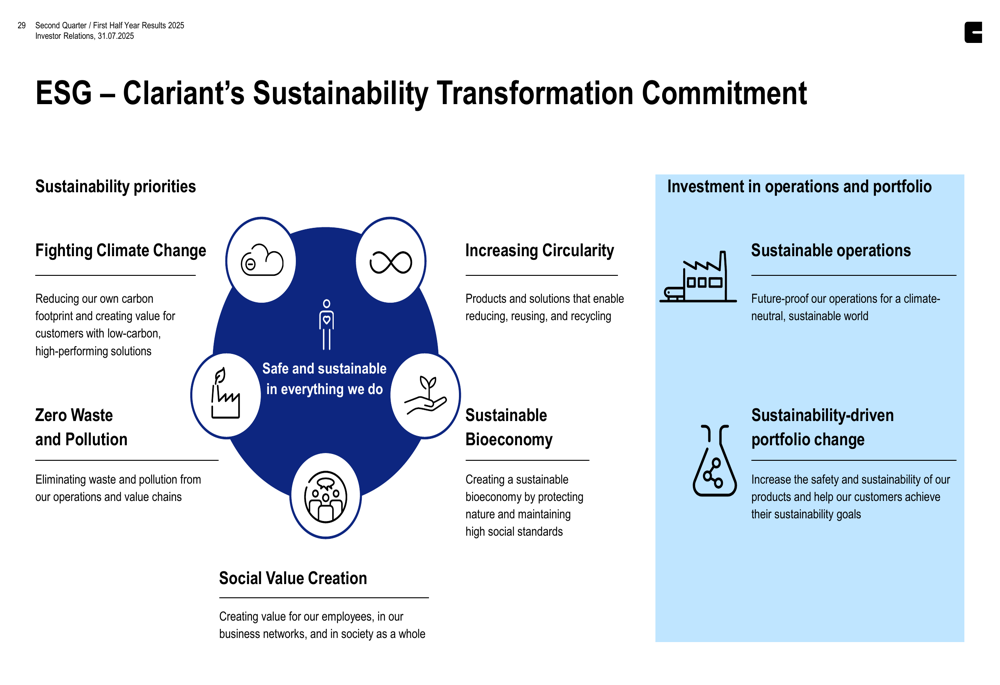
The company’s greenhouse gas emissions reduction progress is shown here:

Conclusion
Clariant’s Q2 and H1 2025 results reflect a company in transition, successfully improving profitability through restructuring while facing challenging market conditions that have impacted top-line growth. The company’s strategic shift toward consumer markets and focus on sustainability appear to be yielding positive results in terms of margin improvement, though growth remains constrained by the broader economic environment.
As Clariant continues to execute its restructuring program and sustainability initiatives, investors will be watching closely to see if the company can return its ROIC above its cost of capital and achieve its medium-term targets despite the current headwinds in industrial production.
Full presentation:
This article was generated with the support of AI and reviewed by an editor. For more information see our T&C.
